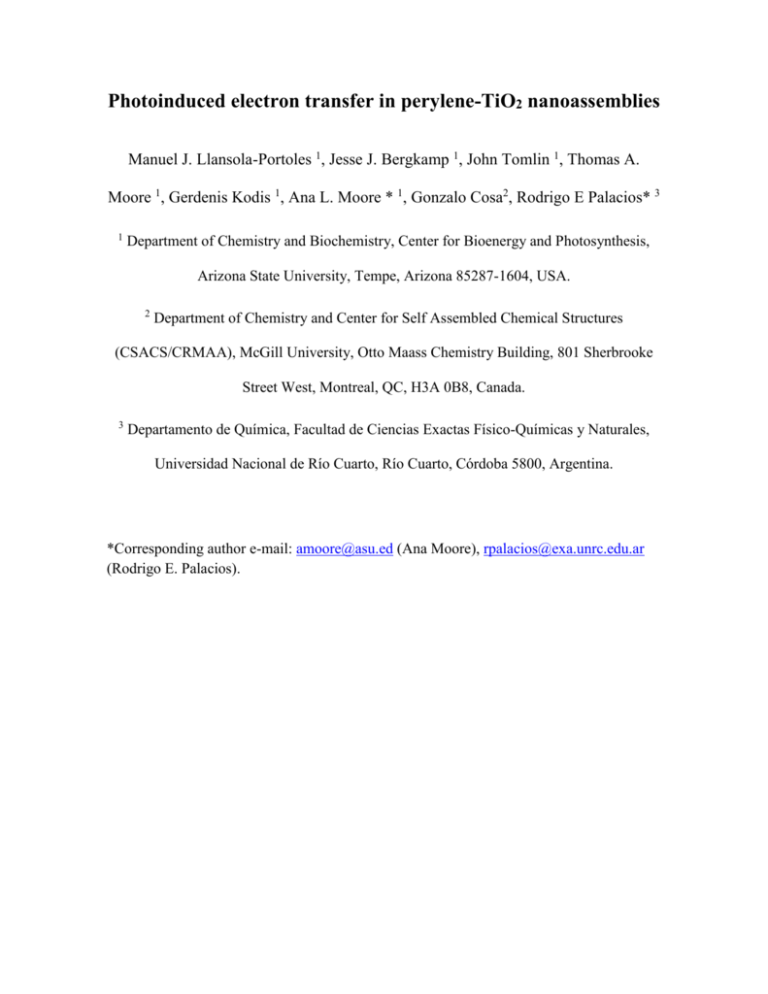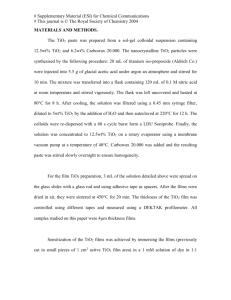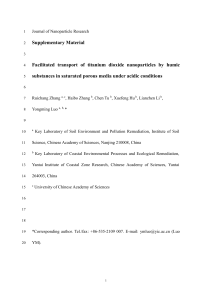Photoinduced electron transfer in perylene-TiO2
advertisement

Photoinduced electron transfer in perylene-TiO2 nanoassemblies Manuel J. Llansola-Portoles 1, Jesse J. Bergkamp 1, John Tomlin 1, Thomas A. Moore 1, Gerdenis Kodis 1, Ana L. Moore * 1, Gonzalo Cosa2, Rodrigo E Palacios* 3 1 Department of Chemistry and Biochemistry, Center for Bioenergy and Photosynthesis, Arizona State University, Tempe, Arizona 85287-1604, USA. 2 Department of Chemistry and Center for Self Assembled Chemical Structures (CSACS/CRMAA), McGill University, Otto Maass Chemistry Building, 801 Sherbrooke Street West, Montreal, QC, H3A 0B8, Canada. 3 Departamento de Química, Facultad de Ciencias Exactas Físico-Químicas y Naturales, Universidad Nacional de Río Cuarto, Río Cuarto, Córdoba 5800, Argentina. *Corresponding author e-mail: amoore@asu.ed (Ana Moore), rpalacios@exa.unrc.edu.ar (Rodrigo E. Palacios). Determination of amount of physisorbed HCl on the surface of TiO2 NPs The amount of physisorbed HCl on the surface of TiO2 NPs was determined weighing 10 mg of TiO2 NPs powder after drying in ultra high vacuum at 25 ºC for 8 hours. That amount is dissolved in 0.025 L of water. Assuming all HCl come off from TiO2 NPs surface into the water, the protons in solution come from the HCl. Hence measuring the pH (pH ~ 4), we can estimate a concentration of ~ 0.01 (g HCl)/(g TiO2 NPs). Transmission Electron Microscopy micrographs of TiO2 Nanoparticles. Figure S1. TEM micrographs of TiO2 NPs. Red circles highlight nanoparticles on the image. MCR analysis for time absorption traces of binding of 2 to TiO2 NPs inside reverse micelles Figure S2. a) Species spectra obtained by MCR analysis of data in reference (1), Figure 1c, corresponding to the basic titration of 2 in ethanol solution. The insert shows the relative concentration of each specie vs concentration of KOH (color coded). b) Species spectra obtained by MCR analysis of data in reference (1), Figure 4c, corresponding to the binding of 2 to TiO2 NPs inside reverse micelles. The insert shows the relative concentration time evolution for each species (color coded). Time sequence of steady state absorption of dye 3 upon incubation with TiO2 NPs Figure S3. Time sequence of absorption spectra collected after addition of 3 to a suspension of TiO2 NPs in THF. [Dye] = ~ 10-6 M, estimated [TiO2 NPs] = ~ 0.1 mg/mL. TC-SPC measurements Figure S4. Fluorescence decay associated spectra of a) Dye 1 in THF recorded upon excitation at 450 nm. Insert displays kinetic trace (data points) and corresponding fit (smooth line) recorded at the indicated wavelength. b) Dye 2 in THF recorded upon excitation at 640 nm. Insert displays kinetic trace (data points) and corresponding fit (smooth line) recorded at the indicated wavelength. Dye concentration was ~ 10-6 M for all samples. Steady state absorption and emission spectra of open and closed dye species upon binding to TiO2 NPs Figure S5. a) Normalized absorption (solid lines) and emission (dashed lines) spectra of dye 1 in THF before (black) and after (red) the attachment to the TiO2 NP. Dashed blue line corresponds to absorption of the TiO2 NPs band gap (BG) transition. Emission spectra was recorded with excitation at ex = 430 nm b) Normalized absorption (solid lines) and emission (dashed lines) spectra of dye 2 in THF before (black) and after (red) the attachment to the TiO2 NP. Emission spectra was recorded with excitation at ex = 640 nm for close form and ex = 550 nm for open form. [Dye] = ~ 10-6 M and [TiO2 NPs] = ~ 0.1 mg/mL for both samples. Femtosecond transient absorption experiments. Kinetic traces Figure S6. Transient absorption kinetics traces at selected wavelengths reordered for: a) 1-TiO2 system in THF recorded upon excitation at 490 nm. b) 2-TiO2 system in THF recorded upon excitation at 640 nm. Estimation of aggregate size from rotational correlation time Considering Brownian motion and the Perrin equation (2), the rotational correlation time () of a spherical particle can be described by Equation S1(2): (S1) V kB T Where, V is the volume of the rotating particle (assumed to be spherical), kB is the Boltzmann constant and η is the solvent viscosity at a given temperature T. For = 890 ps and η (298 K) = 480 µPa·s (THF)(3) the equation S1 yields a nanoparticles radius of 1.2 nm. References. 1. Hernández, L. I., R. Godin, J. J. Bergkamp, M. J. Llansola Portolés, B. D. Sherman, J. Tomlin, G. Kodis, D. D. Méndez-Hernández, S. Bertolotti, C. A. Chesta, E. Mariño-Ochoa, A. L. Moore, T. A. Moore, G. Cosa and R. E. Palacios (2012). Spectral characteristics and photosensitization of tio2 nanoparticles in reverse micelles by perylenes. J. Phys. Chem. B, doi: 10.1021/jp3086792. 2. Lakowicz, J. R. (2006) Principles of fluorescence spectroscopy. Springer, New York, NY. 3. Lide, D. R. (2009) Handbook of chemistry and physics. CRC Press. Inc., Boca Raton.




